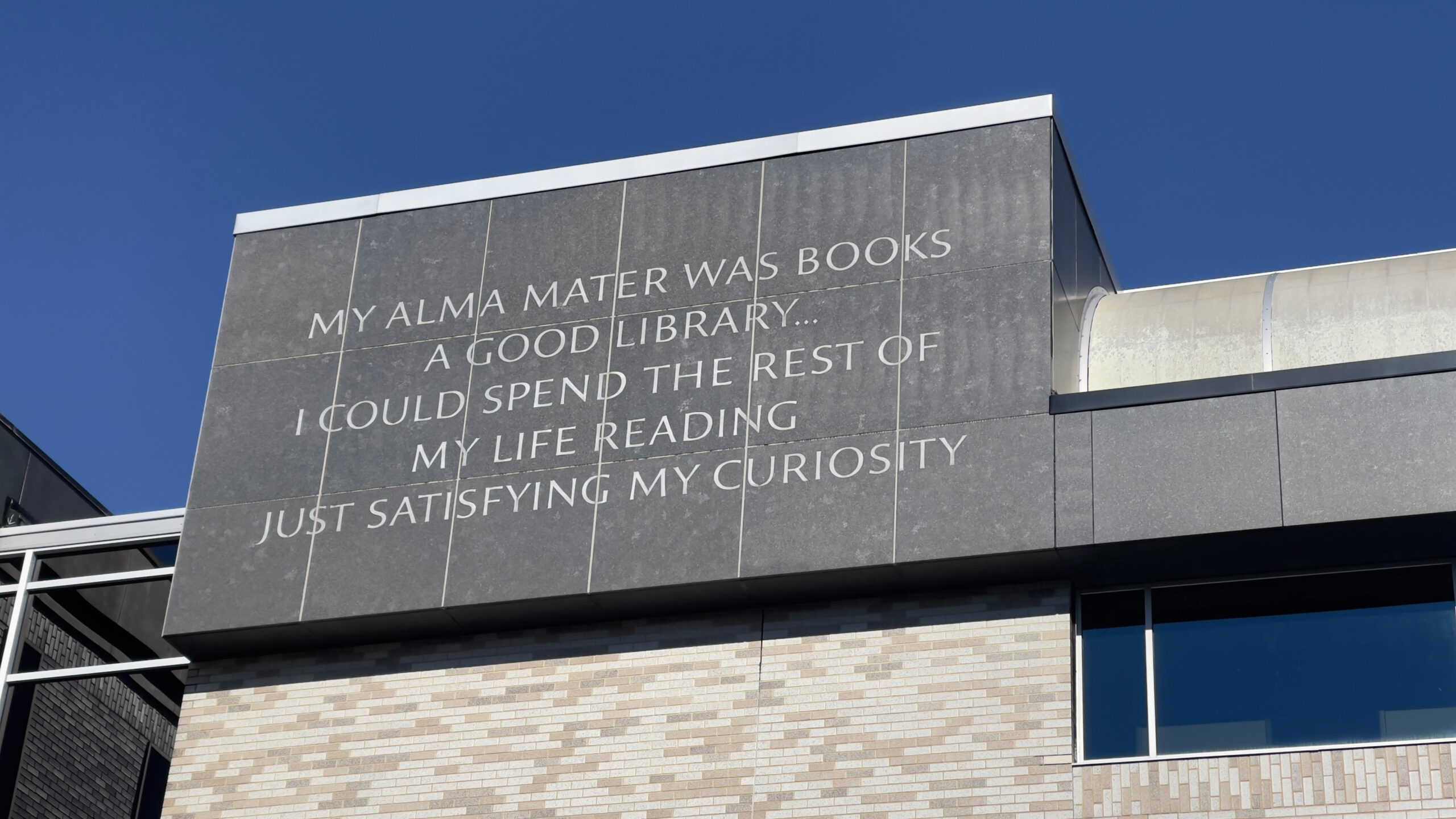Pictured: The misprinted quote on the side on URI’s library. Aidan Cahill | Staff Photographer
On Nov. 10, 1992, the University of Rhode Island’s Black Student Leadership Group (BSLG) peacefully protested and took over Taft Hall in an event now called “The Takeover.”
More than 200 students, led by the newly-formed BSLG, acquitted access to the hall in protest of a Malcolm X misquote being engraved on the Robert L. Carothers Library. The students claimed that the quote “A good library… I could spend my life reading” deliberately left out “If I weren’t here every day fighting the white man,” according to the URI Alumni Website.
“There was a group of students that stood up and had the courage to acknowledge the injustices that were happening at the time,” URI President Marc Parlange said. “We are changing [the incorrect quote], and it’s going to be changed by the end of this year.”
This misquote was the “last domino to fall” before minority students decided to demand administrative and structural change at the University, according to Robert Britto-Oliveira, assistant director of the Multicultural Student Services Center (MSSC).
“Students were taken aback when they found out what the entirety of the [Malcom X] quote was,” former BSLG member Malcolm Anderson ‘94 said. “It just coincided with a bunch of other things that were going on on campus at that time.”
The BSLG created 14 points that they believed would promote diversity and inclusion in all aspects of the URI community. The group’s News Conference Agenda, a document that listed their goals and plan of action for the protest, contained these 14 points. Their goals ranged from calling for minority staff at the Counseling Center to the creation of a Native American studies program, as stated in the agenda.
Britto-Oliveira contended that the BSLG’s 14 points would “hold the University accountable” for their lack of inclusion and “provide possible solutions.”
The BSLG’s work directly led to the creation of an official building for the MSSC, an Africana Studies major, a Malcolm X Reading Room and a chief diversity officer for the University, to name a few impacts.
The Foundation of Alumni Engagement hosted an event in order to commemorate 30 years since The Takeover, as well as acknowledge the BSLG’s fight and legacy. Organized by Britto-Oliveira, the event included a moment of recognition in Taft Hall, performances in the MSSC and a dinner and presentation in the Robert J. Higgins Welcome Center. BSLG members and their families and friends, as well as students, attended.
In addition to showing footage from The Takeover, Britto-Oliveira spoke about the “hard work” and “legacy” of the BSLG through poems.
“There will be no freedom for anyone if the balance isn’t shifted,” poet Marlon Carey said at the event. “True freedom will not be gifted, it must be taken.”
Through their organized protest and takeover, the BSLG sought to “shift the balance” and create opportunities for minority students, according to Britto-Oliveira. He said members of the BSLG believed that a more diversified staff, in conjunction with a building dedicated to minority services, would institute positive change at URI.
“The Takeover” was also a way for minority students to achieve a sense of belonging at the white-dominated University, according to Anderson.
“We belong here,” Anderson said. “We had to find our voice… and change things.”
Members of the BSLG hoped to support diversity at URI, as well as harness unity among students, according to him. They believed these goals could be achieved by the creation of an official multicultural services building.
The former building for the MSSC, now the Uhuru Sasa House, had asbestos, lead in the paint and a damaged boiler, according to John McCray Jr., who was URI’s vice president for student affairs during the BSLG protest.
“It was a trip to walk into the house,” he said. “You had to see this thing. I [thought] the floors would break underneath me.”
Minority students felt unsafe in the building and were looking for a place to feel like they “belonged,” according to Britto-Oliveira.
During the time of the Malcolm X misquote, there was a lack of support on campus for multicultural students. Without minority staff at the Counseling Center and a place on campus to feel comfortable, Britto-Oliveira stated that protesters felt underrepresented and unequal. He said the Takeover was an “agenda… for change.”
With efforts to increase diversity and equality on campus, Parlange believes that “progress is happening, but it can certainly be slow sometimes.” In 1992, the year of The Takeover, URI’s population of 11,000 was two percent black. Today, that number is five percent of 17,000 students.
“Acknowledging the importance of the BSLG, it’s not just something that we can tick off on a box,” Parlange said. “It’s really just the fabric of our community. We want this campus to be a place where students feel welcomed, where people feel heard and appreciated and the [BSLG] students started that.”
The legacy of The Takeover continues in all areas of URI’s Kingston Campus, according to Sara Monteiro ‘08, a volunteer at the MSSC. However, she believes that the fight for justice is not over. The BSLG wanted multiculturalism nationwide.
“Diversity is for everybody. Freedom is for everybody. Education is supposed to be an equalizer, and we cannot have discrimination sitting alongside education,” Monterio said. “Learn and make a legacy. No fight has to be fought alone.

